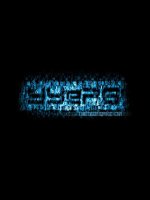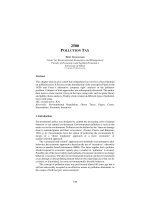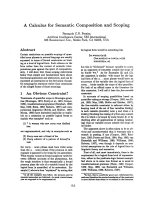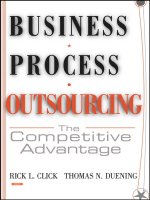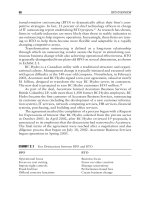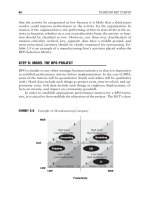- Trang chủ >>
- Đại cương >>
- Toán cao cấp
Hoffmann, laurence d calculus for business, economics, and the social and life sciences mcgraw hill higher education london mcgraw hill distributor (2013)
Bạn đang xem bản rút gọn của tài liệu. Xem và tải ngay bản đầy đủ của tài liệu tại đây (22.27 MB, 803 trang )
BRIEF
EDITION
BRIEF EDITION
FOR BUSINESS, ECONOMICS, AND THE SOCIAL AND LIFE SCIENCES
McGraw-Hill Connect® Mathematics
McGraw-Hill conducted in-depth research to
create a new and improved learning experience that meets the needs of today’s students and
instructors. The result is a reinvented learning experience rich in information, visually engaging,
and easily accessible to both instructors and students. McGraw-Hill’s Connect is a Web-based
assignment and assessment platform that helps students connect to their coursework and
prepares them to succeed in and beyond the course.
Connect Mathematics enables math instructors to create and share courses and assignments
HOFFMANN
with colleagues and adjuncts with only a few clicks of the mouse. All exercises, learning objectives,
videos, and activities are directly tied to text-specific material.
BRADLEY
SOBECKI
PRICE
Integrated Media-Rich eBook
Eleventh Edition
▶ A Web-optimized eBook is seamlessly integrated within
ConnectPlus® Mathematics for ease of use.
▶ Students can access videos, images, and other media in
context within each chapter or subject area to enhance
their learning experience.
▶ Students can highlight, take notes, or even access shared
instructor highlights/notes to learn the course material.
MD DALIM #1167952 10/24/11 CYAN MAG YELO BLK
▶ The integrated eBook provides students with a cost-saving
alternative to traditional textbooks.
McGraw-Hill Tegrity® records and distributes your class lecture, with just a click of a
button. Students can view anytime/anywhere via computer, iPod, or mobile device. It indexes as it
records your PowerPoint® presentations and anything shown on your computer so students can
use keywords to find exactly what they want to study. Tegrity is available as an integrated feature
of McGraw-Hill Connect and Connect Plus.
www.mcgrawhillconnect.com
Eleventh
Edition
ISBN 978-0-07-353238-7
MHID 0-07-353238-X
HOFFMANN | BRADLEY | SOBECKI | PRICE
www.mhhe.com
hof3238x_fm_i-xxiv.qxd
11/25/11
7:27 PM
Page i
Calculus
For Business, Economics, and the Social and Life Sciences
hof3238x_fm_i-xxiv.qxd
11/25/11
7:27 PM
Page ii
hof3238x_fm_i-xxiv.qxd
11/25/11
7:27 PM
Page iii
BRIEF
Eleventh Edition
Calculus
For Business, Economics, and the Social and Life Sciences
Laurence Hoffmann
Morgan Stanley Smith Barney
Gerald Bradley
Claremont McKenna College
Dave Sobecki
Miami University of Ohio
Michael Price
University of Oregon
TM
hof3238x_fm_i-xxiv.qxd
11/25/11
7:27 PM
Page iv
TM
CALCULUS FOR BUSINESS, ECONOMICS, AND THE SOCIAL AND LIFE SCIENCES: BRIEF EDITION,
ELEVENTH EDITION
Published by McGraw-Hill, a business unit of The McGraw-Hill Companies, Inc., 1221 Avenue of the Americas,
New York, NY 10020. Copyright © 2013 by The McGraw-Hill Companies, Inc. All rights reserved. Printed
in the United States of America. Previous editions © 2010, 2007, and 2004. No part of this publication may be
reproduced or distributed in any form or by any means, or stored in a database or retrieval system, without
the prior written consent of The McGraw-Hill Companies, Inc., including, but not limited to, in any network
or other electronic storage or transmission, or broadcast for distance learning.
Some ancillaries, including electronic and print components, may not be available to customers outside the United
States.
This book is printed on acid-free paper.
1 2 3 4 5 6 7 8 9 0 RJE/RJE 1 0 9 8 7 6 5 4 3 2
ISBN 978–0–07–353238–7
MHID 0–07–353238–X
Vice President, Editor-in-Chief: Marty Lange
Vice President, EDP: Kimberly Meriwether David
Senior Director of Development: Kristine Tibbetts
Editorial Director: Michael Lange
Developmental Editor: Eve L. Lipton
Marketing Manager: Alexandra Coleman
Senior Project Manager: Vicki Krug
Senior Buyer: Kara Kudronowicz
Lead Media Project Manager: Judi David
Senior Designer: Laurie B. Janssen
Cover Designer: Ron Bissell
Cover Image: Jillis van Nes, Gettyimages
Senior Photo Research Coordinator: Lori Hancock
Compositor: Aptara®, Inc.
Typeface: 10/12 Times
Printer: R. R. Donnelley
All credits appearing on page or at the end of the book are considered to be an extension of the copyright page.
CO 1, CO 2: © Corbis RF; p. 195(right): © Nigel Cattlin/Photo Researchers, Inc.; p. 195(left): Courtesy of Ricardo
Bessin; CO 3: © Getty RF; CO 4: © The McGraw-Hill Companies, Inc./Jill Braaten, photographer; p. 373:
© Getty RF; CO 5: © Richard Klune/Corbis; p. 477: © Corbis RF; CO 6: © AFP/Getty Images; p. 538:
© Alamy RF; CO 7(right): US Geological Survey; CO 7(left): Courtesy of Trails.com; p. 663: © Getty RF.
Library of Congress Cataloging-in-Publication Data
Calculus for business, economics, and the social and life sciences / Laurence Hoffmann... [et al.]. — Brief 11th ed.
p. cm.
Includes index.
ISBN 978–0–07–353238–7 — ISBN 0–07–353238–X (hard copy: alk. paper) 1. Calculus—Textbooks.
I. Hoffmann, Laurence D., 1943–
QA303.2.H64 2013
515—dc23
2011016379
www.mhhe.com
hof3238x_fm_i-xxiv.qxd
11/25/11
7:27 PM
Page v
In memory of our parents
Doris and Banesh Hoffmann
and
Mildred and Gordon Bradley
hof3238x_fm_i-xxiv.qxd
11/25/11
7:27 PM
Page vi
hof3238x_fm_i-xxiv.qxd
11/25/11
7:27 PM
Page vii
CONTENTS
Preface xi
CHAPTER
1
Functions, Graphs, and Limits
1.1
1.2
1.3
1.4
1.5
1.6
CHAPTER
2
Functions 2
The Graph of a Function 16
Lines and Linear Functions 30
Functional Models 45
Limits 63
One-Sided Limits and Continuity 78
Chapter Summary 91
Important Terms, Symbols, and Formulas 91
Checkup for Chapter 1 91
Review Exercises 92
Explore! Update 97
Think About It 99
Differentiation: Basic Concepts
2.1
2.2
2.3
2.4
2.5
2.6
The Derivative 104
Techniques of Differentiation 119
Product and Quotient Rules; Higher-Order Derivatives 132
The Chain Rule 146
Marginal Analysis and Approximations Using Increments 160
Implicit Differentiation and Related Rates 172
Chapter Summary 185
Important Terms, Symbols, and Formulas 185
Checkup for Chapter 2 186
Review Exercises 186
Explore! Update 193
Think About It 195
vii
hof3238x_fm_i-xxiv.qxd
viii
12/9/11
10:55 AM
Page viii
CONTENTS
CHAPTER
3
Additional Applications of the Derivative
3.1
3.2
3.3
3.4
3.5
CHAPTER
4
Exponential and Logarithmic Functions
4.1
4.2
4.3
4.4
CHAPTER
5
Increasing and Decreasing Functions; Relative Extrema 198
Concavity and Points of Inflection 215
Curve Sketching 233
Optimization; Elasticity of Demand 248
Additional Applied Optimization 266
Chapter Summary 285
Important Terms, Symbols, and Formulas 285
Checkup for Chapter 3 285
Review Exercises 287
Explore! Update 292
Think About It 294
Exponential Functions; Continuous Compounding 298
Logarithmic Functions 314
Differentiation of Exponential and Logarithmic Functions 330
Additional Applications; Exponential Models 345
Chapter Summary 362
Important Terms, Symbols, and Formulas 362
Checkup for Chapter 4 363
Review Exercises 364
Explore! Update 370
Think About It 372
Integration
5.1
5.2
5.3
5.4
5.5
Indefinite Integration and Differential Equations 376
Integration by Substitution 392
The Definite Integral and the Fundamental Theorem
of Calculus 407
Applying Definite Integration: Distribution of Wealth
and Average Value 423
Additional Applications of Integration to Business
and Economics 442
hof3238x_fm_i-xxiv.qxd
11/25/11
7:27 PM
Page ix
CONTENTS
5.6
CHAPTER
6
7
Additional Applications of Integration to the Life
and Social Sciences 453
Chapter Summary 467
Important Terms, Symbols, and Formulas 467
Checkup for Chapter 5 468
Review Exercises 469
Explore! Update 474
Think About It 477
Additional Topics in Integration
6.1
6.2
6.3
6.4
CHAPTER
ix
Integration by Parts; Integral Tables 480
Numerical Integration 494
Improper Integrals 508
Introduction to Continuous Probability 517
Chapter Summary 530
Important Terms, Symbols, and Formulas 530
Checkup for Chapter 6 531
Review Exercises 532
Explore! Update 535
Think About It 538
Calculus of Several Variables
7.1
7.2
7.3
7.4
7.5
7.6
Functions of Several Variables 546
Partial Derivatives 561
Optimizing Functions of Two Variables 577
The Method of Least-Squares 594
Constrained Optimization: The Method of Lagrange Multipliers 606
Double Integrals 621
Chapter Summary 638
Important Terms, Symbols, and Formulas 638
Checkup for Chapter 7 639
Review Exercises 640
Explore! Update 645
Think About It 647
hof3238x_fm_i-xxiv.qxd
x
11/25/11
7:27 PM
Page x
CONTENTS
APPENDIX
A
Algebra Review
A.1
A.2
A.3
A.4
TA B L E S
TEXT SOLUTIONS
I
II
A Brief Review of Algebra 652
Factoring Polynomials and Solving Systems of Equations 663
Evaluating Limits with L’Hôpital’s Rule 675
The Summation Notation 680
Appendix Summary 681
Important Terms, Symbols, and Formulas 681
Review Exercises 682
Think About It 684
Powers of e 685
The Natural Logarithm (Base e) 686
Answers to Odd-Numbered Exercises, Checkup Exercises,
and Review Exercises 687
Index I–1
hof3238x_fm_i-xxiv.qxd
11/25/11
7:27 PM
Page xi
P R E FA C E
Overview of the
Brief Eleventh
Edition
Calculus for Business, Economics, and the Social and Life Sciences, Brief Edition,
provides a sound, intuitive understanding of the basic concepts students need as they
pursue careers in business, economics, and the life and social sciences. Students
achieve success using this text as a result of the authors’ applied and real-world orientation to concepts, problem-solving approach, straightforward and concise writing
style, and comprehensive exercise sets. More than 100,000 students worldwide have
studied from this text!
Improvements to
This Edition
Revised Content
Every section in the text underwent careful analysis and extensive review to ensure
the most beneficial and clear presentation. Additional steps and definition boxes were
added when necessary for greater clarity and precision, graphs and figures were
revised as necessary, and discussions and introductions were added or rewritten as
needed to improve presentation.
Enhanced Topic Coverage
Material on the extreme value property for functions of two variables and finding
extreme values on closed, bounded regions has been added to Section 7.3. This completes the analogy with the single-variable case and better prepares students for future
study of statistics and finite mathematics.
Improved Exercise Sets
Almost 250 new routine and application exercises have been added to the already
extensive problem sets. A wealth of new applied problems has been added to help
demonstrate the practicality of the material, and existing applications have been
updated. Moreover, exercise sets have been rearranged so that applications are grouped
in categories (business/economics, life and social sciences, and miscellaneous).
New Pedagogical Design Elements
Titles have been added to each example in the text, and learning objectives have been
specified at the beginning of each section. Example titles allow both students and
instructors to quickly find items of interest to them. These pedagogical improvements
make the topics clear and comprehensible for all students, help to organize ideas, and
aid both students and professors with review and evaluation.
Online Matrix Supplement
The authors have fully revised the matrix supplement. Problems and examples
have been revised and updated to include more contemporary applications. The revised
supplement in PDF format is posted online for instructors to download at
www.mhhe.com/hoffmann.
Chapter-by-Chapter Changes
• Titles have been added to all worked examples throughout the book.
• A list of learning objectives has been added at the beginning of every section.
• End-of-section exercises have been grouped according to subject.
xi
hof3238x_fm_i-xxiv.qxd
xii
11/25/11
7:27 PM
Page xii
PREFACE
Chapter 1
• New applied exercises have been added to Sections 1.1 through 1.5.
• Material in Section 1.2 on the rectangular coordinate system, the distance
formula, intercepts, and quadratic functions has been added and rewritten. New
and revised examples support these changes.
• In Section 1.4, the coverage of modeling has been revised and includes both
new and revised examples.
• New notes, modified language, and new and revised examples in Section 1.5
help to clarify the topics of limits and infinity.
• A new example on break-even analysis has been added to Section 1.6.
• New Just-In-Time Reviews have been added to Sections 1.2 and 1.5.
Chapter 2
• The boxes for the constant multiple rule and sum rule have been rewritten to
include the prime notation versions of the rules.
• Many introductions have been rewritten with an eye toward achieving better
focus on describing a concept with greater clarity.
• Ten new exercises have been added to Section 2.3 (Exercises 36 through 39)
and 2.4 (Exercises 61 through 64, 89, and 90).
• A new example using the chain rule twice has been added to Section 2.4.
• Section 2.5 includes a new introduction to marginal cost with a new example
illustrating marginal cost and revenue. New exercises on marginal cost and
revenue have also been added.
• A new introduction to implicit differentiation has been added, and there is a
new Just-In-Time Review on related rates.
Chapter 3
• A new introductory example for increasing and decreasing functions has been
added.
• There is a new discussion of worker efficiency and point of diminishing returns.
• The discussion and definition of inflection points and the box summarizing
curve sketching with the second derivative have been modified.
• New exercises have been added in Sections 3.2 and 3.4.
• The material on price elasticity of demand has been completely rewritten.
• The chapter summary has been modified.
Chapter 4
• Boxes on the present and future values of an investment have been updated.
• New exercises on investment have been added in Section 4.1 and on elasticity
of demand in Section 4.3.
• A new example with a new demand function has been added to Section 4.3.
Chapter 5
• In Section 5.1, there is a new introduction to differential equations and a new
example on continuous compounding.
• There are 20 new exercises in Sections 5.1 and 5.3 (a total of 35 new exercises
have been added throughout Chapter 5).
hof3238x_fm_i-xxiv.qxd
11/25/11
7:27 PM
Page xiii
PREFACE
•
•
•
•
xiii
A new subsection on the price-adjustment model in economics has been
moved from Section 6.2 to Section 5.2, and new examples on price adjustment
and a separable differential equation using substitution have been added to
Section 5.2.
There is a new introduction to Section 5.5.
The table of Gini indices for various countries has been updated.
The subsections on Consumer Willingness to Spend and Consumers’ Surplus
have been completely rewritten.
Chapter 6
• Old examples have been deleted from Section 6.1 in favor of a new applied
example using the integral table to solve a logistic equation.
• Twenty-seven new exercises have been added to Chapter 6.
• A new introduction to improper integrals, new discussion and summary boxes
for improper integrals involving Ϫϱ, and a new example are included in
Section 6.3.
Chapter 7
• Twenty-six new exercises have been added to Chapter 7.
• Data in Section 7.4 have been updated.
• Section 7.3 has been substantially revised. There is a new introduction to
practical optimization, and a subsection involving optimization on a closed,
bounded region (the extreme value property) has been added. This material
helps students see how one- and two-dimensional optimization problems are
related.
• A new subsection on finding population from population density has been
added to Section 7.6.
hof3238x_fm_i-xxiv.qxd
11/25/11
7:27 PM
Page xiv
KEY FEATURES OF THIS TEXT
Learning Objectives
1.
2.
3.
4.
Examine slopes of tangent lines and rates of change.
Define the derivative, and study its basic properties.
Compute and interpret a variety of derivatives using the definition.
Study the relationship between differentiability and continuity.
EXPLORE!
Refer to Example 3.5.4. Store
75
300
P( x) ϭ
ϩ
x
15 Ϫ x
into Y1, and graph using the
modified decimal window
[0, 14]1 by [0, 350]10. Now
use TRACE to move the
cursor from X ϭ 1 to 14 and
confirm the location of minimal
pollution. To view the behavior
of the derivative PЈ(x), enter
Y2 ϭ nDeriv(Y1, X, X) and
graph using the window
[0, 14]1 by [Ϫ75, 300]10.
What do you observe?
EXAMPLE 3.5.4 Finding a Location That Minimizes Pollution
Two industrial plants, A and B, are located 15 miles apart and emit 75 ppm (parts per
million) and 300 ppm of particulate matter, respectively. Each plant is surrounded by
a restricted area of radius 1 mile in which no housing is allowed, and the concentration of pollutant arriving at any other point Q from each plant decreases with the
reciprocal of the distance between that plant and Q. Where should a house be located
on a road joining the two plants to minimize the total pollution arriving from both
plants?
Solution
Suppose a house H is located x miles from plant A and, hence, 15 Ϫ x miles from
plant B, where x satisfies 1 Յ x Յ 14 since there is a 1-mile restricted area around
each plant (Figure 3.49). Since the concentration of particulate matter arriving at H
from each plant decreases with the reciprocal of the distance from the plant to H, the
75
300
concentration of pollutant from plant A is
and from plant B is
. Thus, the
x
15 Ϫ x
total concentration of particulate matter arriving at H is given by the function
ϩ
300
15 Ϫ x
5
75
x
5
P(x) ϭ
pollution
from A
pollution
from B
Learning Objectives
Each section begins with a list of objectives for that section.
In addition to preparing students for what they will learn,
these help students organize information for study and review
and make connections between topics.
Applications
Throughout the text great effort is made to ensure that topics
are applied to practical problems soon after their introduction,
providing methods for dealing with both routine computations
and applied problems. These problem-solving methods and
strategies are introduced in applied examples and practiced
throughout in the exercise sets.
“The example titles are a really excellent idea. From the student’s perspective,
they stimulate interest and get the students to read examples that interest
them. From the instructor’s perspective, they allow the instructor to make a
decision about what to include without spending a lot of preparation time
reading each example”.
—Jay Zimmerman, Towson University
Procedural Examples and Boxes
Each new topic is approached with careful clarity by providing step-by-step
problem-solving techniques through frequent procedural examples and
summary boxes.
Relative and Percentage Rates of Change ■ The relative rate of
change of a quantity Q(x) with respect to x is given by the ratio
Relative rate of Q¿(x)
ϭ
change of Q(x)
Q(x)
The corresponding percentage rate of change of Q(x) with respect to x is
A General Procedure for Sketching the Graph of f (x)
Step 1. Find the domain of f(x) [that is, where f(x) is defined].
Step 2. Find and plot all intercepts. The y intercept (where x ϭ 0) is usually easy
to find, but the x intercepts [where f(x) ϭ 0] may require a calculator.
Step 3. Determine all vertical and horizontal asymptotes of the graph. Draw the
asymptotes in a coordinate plane.
Step 4. Find fЈ(x), and use it to determine the critical numbers of f (x) and intervals of increase and decrease.
Step 5. Determine all relative extrema (both coordinates). Plot each relative
maximum with a cap ( ) and each relative minimum with a cup ( ).
Step 6. Find f Љ(x), and use it to determine intervals of concavity and points of
inflection. Plot each inflection point with a “twist” to suggest the shape
of the graph near the point.
Step 7. You now have a preliminary graph, with asymptotes in place, intercepts
plotted, arrows indicating the direction of the graph, and caps, cups, and
twists suggesting the shape at key points. Plot additional points if
needed, and complete the sketch by joining the plotted points in the
directions indicated. Be sure to remember that the graph cannot cross a
vertical asymptote.
Definitions
Definitions and key concepts are set off in shaded
boxes to provide easy referencing for the student.
Percentage rate of 100 Q¿(x)
ϭ
change of Q(x)
Q(x)
Just-In-Time REVIEW
Just-In-Time Reviews
These references, located in the margins, are used to quickly remind
students of important concepts from college algebra or precalculus as
they are being used in examples and review.
xiv
In Example 1.5.6, we perform
the multiplication
( 1x Ϫ 1)( 1x ϩ 1) ϭ x Ϫ 1
using the identity
(a Ϫ b)(a ϩ b) ϭ a2 Ϫ b2
with 1x corresponding to a
and 1 corresponding to b.
hof3238x_fm_i-xxiv.qxd
11/25/11
7:27 PM
Page xv
xv
KEY FEATURES OF THIS TEXT
■
1
1
1. C(x) ϭ x2 ϩ 4x ϩ 57; p(x) ϭ (48 Ϫ x)
5
4
1
1
2. C(x) ϭ x2 ϩ 3x ϩ 67; p(x) ϭ (45 Ϫ x)
4
5
1
3. C(x) ϭ x2 ϩ 2x ϩ 39; p(x) ϭ Ϫx2 Ϫ 10x ϩ 4,000
3
5
4. C(x) ϭ x2 ϩ 5x ϩ 73; p(x) ϭ Ϫ2x2 Ϫ 15x ϩ 6,000
9
1
3 ϩ 2x
5. C(x) ϭ x2 ϩ 43; p(x) ϭ
4
1ϩx
2
Exercise Sets
Almost 250 new problems have been added to
increase the effectiveness of the highly praised
exercise sets. Routine problems have been added
where needed to ensure students have enough practice
to master basic skills, and a variety of applied
problems have been added to help demonstrate the
practicality of the material.
2.5
In Exercises 1 through 6, C(x) is the total cost of
producing x units of a particular commodity and
p(x) is the unit price at which all x units will be sold.
Assume p(x) and C(x) are in dollars.
(a) Find the marginal cost and the marginal
revenue.
(b) Use marginal cost to estimate the cost of producing the 21st unit. What is the actual cost of
producing the 21st unit?
(c) Use marginal revenue to estimate the revenue
derived from the sale of the 21st unit. What is
the actual revenue obtained from the sale of the
21st unit?
12 ϩ 2x
2
BUSINESS AND ECONOMICS APPLIED PROBLEMS
11. BUSINESS MANAGEMENT Leticia manages
a company whose total weekly revenue is
R(q) ϭ 240q Ϫ 0.05q2
dollars when q units are produced and sold.
Currently, the company produces and sells
80 units a week.
a. Using marginal analysis, Leticia estimates the
additional revenue that will be generated by
the production and sale of the 81st unit. What
does she discover? Based on this result,
should she recommend increasing the level
of production?
b. To check her results, Leticia uses the revenue
function to compute the actual revenue
generated by the production and sale of the
81st unit. How accurate was her result found
by marginal analysis?
12. MARGINAL ANALYSIS A manufacturer’s total
cost is C(q) ϭ 0.001q3 Ϫ 0.05q2 ϩ 40q ϩ 4,000
dollars, where q is the number of units produced.
a. Use marginal analysis to estimate the cost of
producing the 251st unit.
b. Compute the actual cost of producing the
251st unit.
Writing Exercises
These problems, designated by writing icons, challenge
a student’s critical thinking skills and invite students to
research topics on their own.
Calculator Exercises
Calculator icons designate problems within each section
that can only be completed with a graphing calculator.
Important Terms, Symbols, and Formulas
f is increasing if fЈ(c) Ͼ 0 (200)
f is decreasing if f Ј(c) Ͻ 0 (200)
Critical point: (c, f(c)), where fЈ(c) ϭ 0 or fЈ(c)
does not exist (202)
Relative maxima and minima (202)
First derivative test for relative extrema: (204)
If fЈ(c) ϭ 0 or fЈ(c) does not exist, then
f' > 0
f' < 0
f' < 0
c
Relative
maximum at x = c
f' > 0
c
Relative maximum
if f " (c) < 0
f' > 0
c
Relative
minimum at x = c
f' > 0
f' < 0
c
f' < 0
c
No extremum
at x = c
Point of diminishing returns (215)
Concavity: (216)
c
Relative minimum
if f " (c) > 0
Vertical asymptote (234
Horizontal asymptote (235)
Absolute maxima and minima (248)
Extreme value property: (249)
Absolute extrema of a continuous function on a
closed interval a Յ x Յ b occur at critical
numbers in a Ͻ x Ͻ b or at endpoints of the
interval (a or b).
Second derivative test for absolute extrema: (253)
If f(x) has only one critical number x ϭ c on an
interval I, then f(c) is an absolute maximum on I
if f Љ(c) Ͻ 0 and an absolute minimum if f Љ(c) Ͼ 0.
Profit P(q) ϭ R(q) Ϫ C(q) is maximized when
marginal revenue equals marginal cost:
RЈ(q) ϭ CЈ(q). (255)
C(q)
Average cost A(q) ϭ
is minimized when average
q
cost equals marginal cost: A(q) ϭ CЈ(q)
CHAPTER SUMMARY
“[Hoffmann-Bradley] has excellent application problems in the social
science, life science, economics, and finance fields.”
—Rebecca Leefers, Michigan State
University–East Lansing
found to be approximately 3.8 million years old.
a. Approximately what percentage of original 14C
would you expect to find if you tried to apply
carbon dating to Lucy? Why would this be a
problem if you were actually trying to “date”
Lucy?
b. In practice, carbon dating works well only for
relatively “recent” samples—those that are no
more than approximately 50,000 years old. For
older samples, such as Lucy, variations on
carbon dating have been developed, such as
potassium-argon and rubidium-strontium dating.
Read an article on alternative dating methods,
and write a paragraph on how they are used.*
84. RADIOLOGY The radioactive isotope
gallium-67 (67Ga), used in the diagnosis of
malignant tumors, has a half-life of 46.5 hours. If
we start with 100 milligrams of the isotope, how
many milligrams will be left after 24 hours? When
will there be only 25 milligrams left? Answer
these questions by first using a graphing utility to
graph an appropriate exponential function and then
using the TRACE and ZOOM features.
85. A population model developed by the U.S. Census
Bureau uses the formula
202.31
P(t) ϭ
1 ϩ e3.938Ϫ0.314t
the given population model seem to be
accurate? (Remember to exclude Alaska and
Hawaii.) Write a paragraph describing some
possible reasons for any major differences
between the predicted population figures and
the actual census figures.
86. Use a graphing utility to graph y ϭ 2Ϫx, y ϭ 3Ϫx,
y ϭ 5Ϫx, and y ϭ (0.5)Ϫx on the same set of
axes. How does a change in base affect the graph
of the exponential function? (Suggestion: Use the
graphing window [Ϫ3, 3]1 by [Ϫ3, 3]1.)
87. Use a graphing utility to draw the graphs of
y ϭ 13x, y ϭ 13Ϫx, and y ϭ 3Ϫx on the same set
of axes. How do these graphs differ? (Suggestion:
Use the graphing window [Ϫ4, 4]1 by [Ϫ2, 6]1.)
88. Use a graphing utility to draw the graphs of y ϭ 3x
and y ϭ 4 Ϫ ln 1x on the same axes. Then
use TRACE and ZOOM to find all points of
intersection of the two graphs.
89. Solve this equation with three decimal place
accuracy:
log5(x ϩ 5) Ϫ log2 x ϭ 2 log10(x2 ϩ 2x)
90. Use a graphing utility to draw the graphs of
1
y ϭ ln(1 ϩ x2) and y ϭ
x
on the same axes. Do these graphs intersect?
1
Chapter Review
Chapter Review material aids the student in synthesizing the
important concepts discussed within the chapter, including a
master list of key technical terms and formulas introduced in
the chapter.
(256)
Chapter Checkup
Chapter Checkups provide a quick quiz for students to test
their understanding of the concepts introduced in the chapter.
CHAPTER SUMMARY
EXERCISES
Checkup for Chapter 2
1. In each case, find the derivative
a. y ϭ 3x4 Ϫ 42x ϩ
dy
.
dx
5
Ϫ7
x2
b. y ϭ (3x3 Ϫ x ϩ 1)(4 Ϫ x2)
5x2 Ϫ 3x ϩ 2
c. y ϭ
1 Ϫ 2x
d. y ϭ (3 Ϫ 4x ϩ 3x2)3ր2
2. Find the second derivative of the function
f(t) ϭ t(2t ϩ 1)2.
3. Find an equation for the tangent line to the curve
y ϭ x2 Ϫ 2x ϩ 1 at the point where x ϭ Ϫ1.
4. Find the rate of change of the function
xϩ1
f(x) ϭ
with respect to x when x ϭ 1.
1 Ϫ 5x
5. PROPERTY TAX Records indicate that x years
after the year 2010, the average property tax on a
four-bedroom home in a suburb of a major city
was T(x) ϭ 3x2 ϩ 40x ϩ 1,800 dollars.
a. At what rate is the property tax increasing with
respect to time in 2013?
b. At what percentage rate is the property tax
increasing in 2013?
7. PRODUCTION COST Suppose the cost
of producing x hundred units of a particular
commodity is C(x) ϭ 0.04x2 ϩ 5x ϩ 73 thousand
dollars. Use marginal cost to estimate the cost of
producing the 410th unit. What is the actual cost
of producing the 410th unit?
8. INDUSTRIAL OUTPUT At a certain factory,
the daily output is Q ϭ 500L3͞4 units, where L
denotes the size of the labor force in workerhours. Currently, 2,401 worker-hours of labor are
used each day. Use calculus (increments) to
estimate the effect on output of increasing the size
of the labor force by 200 worker-hours from its
current level.
9. PEDIATRIC MEASUREMENT Pediatricians
use the formula S ϭ 0.2029w0.425 to estimate the
surface area S (m2) of a child 1 meter tall who
weighs w kilograms (kg). A particular child
weighs 30 kg and is gaining weight at the rate
of 0.13 kg per week while remaining 1 meter tall.
At what rate is this child’s surface area changing?
10. GROWTH OF A TUMOR A cancerous tumor
is modeled as a sphere of radius r cm.
4
a. At what rate is the volume V ϭ r3 changing
3
xv
hof3238x_fm_i-xxiv.qxd
7:27 PM
Page xvi
KEY FEATURES OF THIS TEXT
Review Problems
A wealth of additional routine and applied problems
is provided within the end-of-chapter exercise sets,
offering further opportunities for practice.
Review Exercises
In Exercises 1 through 10, use integration by parts to find
the given integral.
1.
3.
͵
͵
͵
͵
͵
͵
x12x ϩ 3 dx
ln 1s
ds
1s
4
5.
1
1
7.
8.
9.
2.
te1Ϫt dt
4.
6.
͵
͵
͵
(5 ϩ 3x)eϪxր2 dx
Ϫ1
Ϫ9
y dy
14 Ϫ 5y
(ln x)2 dx
(2x ϩ 1)(x ϩ 3)3ր2 dx
w3
dw
x3 23x2 ϩ 2 dx
͵
1
10.
27.
29.
31.
33.
Ϫ2
21 ϩ w2
25.
0
xϩ2
e3x
͵
͵
͵
͵
͵
ϩϱ
Ϫ2x
xe
dx
0
ϩϱ
x2 eϪ2x dx
0
ϩϱ
28.
ln x
dx
1x
30.
xexϩ1 dx
32.
1
Ϫ1
Ϫϱ
ϱ
26.
3 Ϫx2
x e
Ϫϱ
͵
͵
͵
͵
͵
ϩϱ
2x e
0
ϩϱ
34.
1
t (ln
2
ϩϱ
2
dx
dt
t)
xϪ1
dx
xϩ2
0
0
dx
2 Ϫx3
e2x ϩ
Ϫϱ
ϱ
1
(x Ϫ 1)2
dx
Ϫx
(e ϩ e ) dx
x
Ϫϱ
In Exercises 35 through 38, integrate the given probability density functions to find the indicated probabilities.
dx
Ά
1
35. f(x) ϭ 3
if 1 Յ x Յ 4
Explore! Technology
Utilizing the graphing calculator, Explore Boxes
challenge a student’s understanding of the topics
presented with explorations tied to specific examples.
Explore! Updates provide solutions and hints to
selected boxes throughout the chapter.
THINK ABOUT IT
ALLOMETRIC MODELS
When developing a mathematical model, the first task is to identify quantities of
interest, and the next is to find equations that express relationships between these
quantities. Such equations can be quite complicated, but there are many important
relationships that can be expressed in the relatively simple form y ϭ Cxk, in which
one quantity y is expressed as a constant multiple of a power function of another
quantity x.
In biology, the study of the relative growth rates of various parts of an organism is
called allometry, from the Greek words allo (other or different) and metry (measure).
In allometric models, equations of the form y ϭ Cxk are often used to describe the
relationship between two biological measurements. For example, the size a of the
antlers of an elk from tip to tip has been shown to be related to h, the shoulder height
of the elk, by the allometric equation
THINK ABOUT IT
“The book as a whole is one of the best calculus books I have
used.... I really like how calculators are included on every section
and that at the end of the chapter there is opportunity for students
to explore the calculators even more.”
—Joseph Oakes, Indiana University Southeast
EXPLORE! UPDATE
CHAPTER SUMMARY
xvi
11/25/11
EXPLORE! UPDATE
Complete solutions for all EXPLORE! boxes throughout the text can be accessed at
the book-specific website, www.mhhe.com/hoffmann.
Solution for Explore!
on Page 377
Store the constants {Ϫ4, Ϫ2, 2, 4} into L1, and write Y1 ϭ X^3 and Y2 ϭ Y1 ϩ L1.
Graph Y1 in bold, using the modified decimal window [Ϫ4.7, 4.7]1 by [Ϫ6, 6]1. At
x ϭ 1 (where we have drawn a vertical line), the slopes for each curve appear equal.
Using the tangent line feature of your graphing calculator, draw tangent lines at x ϭ 1
for several of these curves. Every tangent line at x ϭ 1 has a slope of 3, although
each line has a different y intercept.
Think About It Essays
The modeling-based Think About It essays show students
how material introduced in the chapter can be used to
construct useful mathematical models while explaining the
modeling process and providing an excellent starting point
for projects or group discussions.
hof3238x_fm_i-xxiv.qxd
11/25/11
7:27 PM
Page xvii
SUPPLEMENTS
xvii
Also available . . .
Applied Calculus for Business, Economics, and the Social and Life
Sciences, Expanded Eleventh Edition
ISBN–13: 978-0-07-353237-0 (ISBN–10: 0-07-353237-1)
The Expanded Eleventh Edition contains all the material present in the Brief Eleventh
Edition of Calculus for Business, Economics, and the Social and Life Sciences, plus
four additional chapters covering Trigonometric Functions, Differential Equations,
Infinite Series and Taylor Series Approximations, and Probability and Calculus.
Supplements
Student’s Solutions Manual
The Student’s Solutions Manual contains comprehensive, worked-out solutions for
all odd-numbered problems in the text with the exception of the Checkup section
for which solutions to all problems are provided. Detailed calculator instructions
and keystrokes are also included for problems marked by the calculator icon.
ISBN–13: 978-0-07-742738-2 (ISBN–10: 0-07-742738-6)
Instructor’s Solutions Manual
The Instructor’s Solutions Manual contains comprehensive, worked-out solutions for all
problems in the text and is available on the book’s website, www.mhhe.com/hoffmann.
Computerized Test Bank
Brownstone Diploma testing software, available on the book’s website, offers instructors a quick and easy way to create customized exams and view student results. The
software utilizes an electronic test bank of short answer, multiple choice, and true/false
questions tied directly to the text, with many new questions added for the Eleventh
Edition. Sample chapter tests and final exams in Microsoft Word and PDF formats
are also provided.
Connect www.mcgraw-hillconnect.com
McGraw-Hill Connect® is a complete online system for mathematics. A variety of
study tools are available at any time, including videos, applets, worked examples,
algorithmic exercises, and lecture capture software, offering unlimited practice and
accommodating many different learning styles. An answer palette is available for
many exercises, allowing the entry of mathematical symbols without struggling with
keyboard commands. Students can also benefit from immediate feedback like guided
solutions, access to the textbook online, and checking an answer, all directly accessible right from a Connect assignment. Connect can be used on Macs and PCs as well
as on several different browsers, making it flexible to meet a wide range of student
needs. Connect offers full Blackboard integration, making electronic record keeping
even easier.
For more information, visit the book’s website (www.mhhe.com/hoffmann) or
contact your local McGraw-Hill sales representative (www.mhhe.com/rep).
hof3238x_fm_i-xxiv.qxd
xviii
11/25/11
7:27 PM
Page xviii
SUPPLEMENTS
Electronic Textbooks
McGraw-Hill ConnectPlus®
ConnectPlus provides students with all the advantages of Connect, plus 24/7 access
to a media-rich, interactive eBook. Included is a powerful suite of built-in tools that
allow detailed searching, highlighting, note taking, and student-to-student or instructorto-student note sharing. In addition, ConnectPlus integrates relevant animations, interactives, and videos into the textbook content for a true multimedia learning experience.
McGraw-Hill Create™
Craft your teaching resources to match the way you teach. With Create, at
www.mcgrawhillcreate.com, you can easily rearrange chapters, combine material from
other content sources, and quickly upload content you have written like your course
syllabus or teaching notes. Find the content you need in Create by searching through
thousands of leading McGraw-Hill textbooks. Arrange your book to fit your teaching
style. Create even allows you to personalize your book’s appearance by selecting the
cover and adding your name, school, and course information. Order a Create book
and you’ll receive a complimentary print review copy in 3 to 5 business days or a
complimentary electronic review copy (eComp) via e-mail in about 1 hour. Go to
www.mcgrawhillcreate.com today and register. Experience how Create empowers you
to teach your students your way.
CourseSmart
CourseSmart is a new way for faculty to find and review e-textbooks. With the
CourseSmart eTextbook version of Calculus for Business, Economics, and the Social
and Life Sciences, Eleventh Edition, students can save up to 50 percent off the cost
of a print book, reduce their impact on the environment, and access powerful Web
tools for learning, including full text search, notes, highlighting, and e-mail tools for
sharing notes between classmates. Faculty can also review and compare the full text
online without having to wait for a print desk copy. CourseSmart is an online e-textbook,
which means users need to be connected to the Internet to access it. Students can also
print sections of the book for maximum portability.
ALEKS (Assessment and LEarning in Knowledge Spaces) is a unique, online program that dramatically raises student proficiency and success rates in mathematics,
while reducing faculty workload and office-hour lines. ALEKS uses artificial intelligence and adaptive, open-response questioning to assess precisely a student’s preparedness and provide personalized instruction on the exact topics the student is most
ready to learn. As a result, ALEKS interacts with students much like a skilled human
tutor to improve student confidence and performance. Additionally, ALEKS includes
robust course management tools that allow instructors to spend less time on administrative tasks and more time directing student learning.
ALEKS Prep for Calculus
ALEKS Prep for Calculus focuses on prerequisite and introductory material for Calculus,
and can be used during the first 6 weeks of the term to prepare students for success in
the course. Through comprehensive explanations, practice, and feedback, ALEKS enables
students to quickly fill gaps in prerequisite knowledge. As a result, instructors can focus
on core course concepts instead of review material, and see fewer drops from the course.
hof3238x_fm_i-xxiv.qxd
11/25/11
7:27 PM
Page xix
SUPPLEMENTS
ALEKS Prep for Calculus Features:
• Artificial Intelligence: Targets gaps in student knowledge
• Individualized Assessment and Learning: Ensure student mastery
• Dynamic, Automated Reports: Monitor student and class progress
• Adaptive, Open-Response Environment: Avoids multiple-choice
For more information about ALEKS, please visit: www.aleks.com/highered/math.
ALEKS is a registered trademark of ALEKS Corporation.
xix
hof3238x_fm_i-xxiv.qxd
xx
11/25/11
7:27 PM
Page xx
ACKNOWLEDGMENTS
Acknowledgments
As in past editions, we have enlisted the feedback of professors teaching from our
text as well as those using other texts to point out possible areas for improvement.
Our reviewers provided a wealth of detailed information on both our content and
the changing needs of their course, and many changes we’ve made were a direct
result of consensus among these review panels. This text owes its considerable success to their valuable contributions, and we thank every individual involved in this
process.
James N. Adair, Missouri Valley College
Wendy Ahrendsen, South Dakota State University
Faiz Al-Rubaee, University of North Florida
George Anastassiou, University of Memphis
Dan Anderson, University of Iowa
Randy Anderson, Craig School of Business
John Avioli, Christopher Newport University
Christina Bacuta, University of Delaware
Ratan Barua, Miami Dade College
John Beachy, Northern Illinois University
Jay H. Beder, University of Wisconsin—Milwaukee
Denis Bell, University of North Florida
Don Bensy, Suffolk County Community College
Adel Boules, University of North Florida
Neal Brand, University of North Texas
Lori Braselton, Georgia Southern University
Randall Brian, Vincennes University
Paul W. Britt, Louisiana State University—Baton Rouge
Albert Bronstein, Purdue University
James F. Brooks, Eastern Kentucky University
Beverly Broomell, State University of New York—Suffolk
Roxanne Byrne, University of Colorado at Denver
Laura Cameron, University of New Mexico
Rick Carey, University of Kentucky
Debra Carney, University of Denver
Jamylle Carter, Diablo Valley College
Steven Castillo, Los Angeles Valley College
Rose Marie Castner, Canisius College
Deanna Caveny, College of Charleston
Gerald R. Chachere, Howard University
Terry Cheng, Irvine Valley College
William Chin, DePaul University
Lynn Cleaveland, University of Arkansas
Dominic Clemence, North Carolina Agricultural and
Technical State University
Charles C. Clever, South Dakota State University
Allan Cochran, University of Arkansas
Flavia Colonna, George Mason University
Peter Colwell, Iowa State University
Cecil Coone, Southwest Tennessee Community College
Charles Brian Crane, Emory University
Daniel Curtin, Northern Kentucky University
Raul Curto, University of Iowa
Jean F. Davis, Texas State University—San Marcos
John Davis, Baylor University
Shirley Davis, South Plains College
Yulia Dementieva, Emmanuel College
Karahi Dints, Northern Illinois University
Ken Dodaro, Florida State University
Eugene Don, Queens College
Dora Douglas, Wright State University
Peter Dragnev, Indiana University–Purdue University,
Fort Wayne
Bruce Edwards, University of Florida
Margaret Ehrlich, Georgia State University
Maurice Ekwo, Texas Southern University
George Evanovich, St. Peter’s College
Haitao Fan, Georgetown University
Brad Feldser, Kennesaw State University
Klaus Fischer, George Mason University
Guy Forrest, Louisiana State University—Baton Rouge
Michael Freeze, University of North Carolina—
Wilmington
Constantine Georgakis, DePaul University
Sudhir Goel, Valdosta State University
Hurlee Gonchigdanzan, University of Wisconsin—
Stevens Point
Ronnie Goolsby, Winthrop College
Lauren Gordon, Bucknell University
Michael Grady, Loyola Marymount University
Angela Grant, University of Memphis
John Gresser, Bowling Green State University
Murli Gupta, George Washington University
James Hager, Pennsylvania State University
Doug Hardin, Vanderbilt University
Marc Harper, University of Illinois at Urbana—
Champaign
Sheyleah V. Harris-Plant, South Plains College
hof3238x_fm_i-xxiv.qxd
11/25/11
7:27 PM
Page xxi
ACKNOWLEDGMENTS
Jonathan Hatch, University of Delaware
John B. Hawkins, Georgia Southern University
Damon Hay, University of North Florida
Celeste Hernandez, Richland College
William Hintzman, San Diego State University
Frederick Hoffman, Florida Atlantic University
Matthew Hudock, St. Philips College
Joel W. Irish, University of Southern Maine
Zonair Issac, Vanderbilt University
Erica Jen, University of Southern California
Jun Ji, Kennesaw State University
Shafiu Jibrin, Northern Arizona University
Victor Kaftal, University of Cincinnati
Sheldon Kamienny, University of Southern California
Georgia Katsis, DePaul University
Victoria Kauffman, University of New Mexico
Fritz Keinert, Iowa State University
Melvin Kiernan, St. Peter’s College
Marko Kranjc, Western Illinois University
Donna Krichiver, Johnson County Community College
Harvey Lambert, University of Nevada
Kamila Larripa, Humboldt State University
Donald R. LaTorre, Clemson University
Melvin Lax, California State University, Long Beach
Rebecca Leefers, Michigan State University
Steffen Lempp, University of Wisconsin—Madison
Robert Lewis, El Camino College
Shlomo Libeskind, University of Oregon
W. Conway Link, Louisiana State University—
Shreveport
James Liu, James Madison University
Yingjie Liu, University of Illinois at Chicago
Bin Lu, California State University—Sacramento
Jeanette Martin, Washington State University
James E. McClure, University of Kentucky
Mark McCombs, University of North Carolina
Ennis McCune, Stephen F. Austin State University
Ann B. Megaw, University of Texas at Austin
Fabio Milner, Purdue University
Kailash Misra, North Carolina State University
Mohammad Moazzam, Salisbury State University
Rebecca Muller, Southeastern Louisiana University
Sanjay Mundkur, Kennesaw State University
Kandasamy Muthuvel, University of Wisconsin—
Oshkosh
Charlie Nazemian, University of Nevada—Reno
Karla Neal, Louisiana State University
Cornelius Nelan, Quinnipiac University
Said Ngobi, Troy University eCampus
Devi Nichols, Purdue University—West Lafayette
xxi
Joseph Oakes, Indiana University Southeast
Richard O’Beirne, George Mason University
Jaynes Osterberg, University of Cincinnati
Ray Otto, Wright State University
Hiram Paley, University of Illinois
Virginia Parks, Georgia Perimeter College
Shahla Peterman, University of Missouri—St. Louis
Murray Peterson, College of Marin
Lefkios Petevis, Kirkwood Community College
Boris Petracovici, Western Illinois University
Lia Petracovici, Western Illinois University
Cyril Petras, Lord Fairfax Community College
Robert E. Plant, II, South Plains College
Kimberley Polly, Indiana University at Bloomington
Natalie Priebe, Rensselaer Polytechnic Institute
Georgia Pyrros, University of Delaware
Richard Randell, University of Iowa
Mohsen Razzaghi, Mississippi State University
Nathan P. Ritchey, Youngstown State University
Arthur Rosenthal, Salem State College
Judith Ross, San Diego State University
Robert Sacker, University of Southern California
Katherine Safford, St. Peter’s College
Mansour Samimi, Winston-Salem State University
Ronda Sanders, University of South Carolina
Subhash Saxena, Coastal Carolina University
Daniel Schaal, South Dakota State University
Dolores Schaffner, University of South Dakota
Thomas J. Sharp, West Georgia College
Robert E. Sharpton, Miami-Dade Community College
Anthony Shershin, Florida International University
Minna Shore, University of Florida International
University
Ken Shores, Arkansas Tech University
Gordon Shumard, Kennesaw State University
Jane E. Sieberth, Franklin University
Marlene Sims, Kennesaw State University
Brian Smith, Parkland College
Nancy Smith, Kent State University
Jim Stein, California State University, Long Beach
Joseph F. Stokes, Western Kentucky University
Keith Stroyan, University of Iowa
Hugo Sun, California State University—Fresno
Martin Tangora, University of Illinois at Chicago
Tuong Ton-That, University of Iowa
Lee Topham, North Harris Community College
George Trowbridge, University of New Mexico
Boris Vainberg, University of North Carolina at
Charlotte
Nader Vakil, Western Illinois University
hof3238x_fm_i-xxiv.qxd
xxii
11/25/11
7:27 PM
Page xxii
ACKNOWLEDGMENTS
Dinh Van Huynh, Ohio University
Mildred Vernia, Indiana University Southwest
Maria Elena Verona, University of Southern California
Tilaka N. Vijithakumara, Illinois State University
Kimberly Vincent, Washington State University
Karen Vorwerk, Westfield State College
Charles C. Votaw, Fort Hays State University
Hiroko Warshauer, Southwest Texas State University
Pam Warton, Bowling Green State University
Jonathan Weston-Dawkes, University of North Carolina
Donald Wilkin, University at Albany, SUNY
Dr. John Woods, Southwestern Oklahoma State
University
Henry Wyzinski, Indiana University—Northwest
Yangbo Ye, University of Iowa
Paul Yun, El Camino College
Xiao-Dong Zhang, Florida Atlantic University
Jay Zimmerman, Towson University
Special thanks go to those instrumental in checking each problem and page for accuracy, including Devilyna Nichols, Lucy Mullins, Kurt Norlin, Hal Whipple, and Jaqui
Bradley. Special thanks also go to Steffen Lempp and Amadou Gaye for providing
specific, detailed suggestions for improvement that were particularly helpful in preparing this Eleventh Edition. Finally, we wish to thank our McGraw-Hill team, Michael
Lange, John Osgood, Vicki Krug, Christina Lane, and Eve Lipton for their patience,
dedication, and sustaining support.
hof3238x_fm_i-xxiv.qxd
11/25/11
7:27 PM
Page xxiii
Calculus
For Business, Economics, and the Social and Life Sciences
hof3238x_fm_i-xxiv.qxd
11/25/11
7:27 PM
Page xxiv
